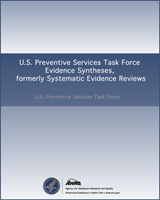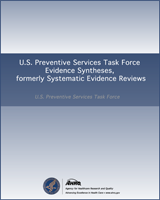NCBI Bookshelf. A service of the National Library of Medicine, National Institutes of Health.
This publication is provided for historical reference only and the information may be out of date.
Structured Abstract
Background:
Diabetes poses a tremendous and increasing clinical and public health burden for Americans; 19.3 million Americans over the age of 20 years are affected, one third of whom are undiagnosed.
Purpose:
To examine the evidence of the potential benefits and harms of screening adults for type 2 diabetes mellitus (DM2) and prediabetes in primary care settings in the United States.
Data Sources:
We searched Medline and the Cochrane Library for reviews and relevant studies published in English between March, 2001 and July, 2007.
Study Selection:
Studies of any design which examined the effects of a DM2 screening program on long-term health outcomes were included. Randomized controlled trials (RCTs) examining the effects of treatments for DM2 in persons with disease duration ≤ 1 year and prediabetes treatment studies were also included, as were RCTs where treatment effects were compared between persons with diabetes and normoglycemia.
Data Extraction:
Data were abstracted by one author and checked by a second. Key studies were reviewed and discussed by all authors.
Results:
There were no RCTs examining the effectiveness of a DM2 screening program. A small, case-control study did not suggest a benefit from screening when microvascular complications were considered. No study directly compared treatment effects between screen-detected and clinically-detected diabetic persons, nor have studies to date reported treatment effects in a screen-detected cohort with diabetes. Modeling studies suggest that screening for DM2 may be relatively cost-effective when macrovascular benefits of optimal blood pressure control are taken into account.
There was no clear evidence that persons with DM2 detected by screening would respond differently to specific antihypertensive regimens compared to persons without diabetes, and persons with diabetes and no known cardiovascular disease benefit from aggressive lipid control to a similar extent as persons without diabetes, but with known cardiovascular disease. In two new studies, aspirin did not appear to reduce the risk of myocardial infarction in DM2, but may lower the risk of ischemic stroke in women. There were no new data examining glycemic control strategies in persons with newly-diagnosed DM2.
Intensive lifestyle and various pharmacotherapeutic interventions decrease the incidence of DM2 over follow-up periods up to 7 years. There were little data, however, on the prevention or delay of cardiovascular and other long-term health outcomes, including death. Limited data from observational studies suggest no serious adverse effects of receiving a diagnosis of DM2 from screening. Recent systematic reviews of the adverse effects of drugs used in the treatment of DM2 and prediabetes do not reveal significant new data on harms.
Limitations:
Direct trial evidence of the benefits or harms of screening is lacking, therefore we relied solely on indirect evidence. Since the natural history of prediabetes and DM2 is not well elucidated, it remains unclear as to how applicable data from persons with DM2 ≤ 1 year is to screen-detected persons. Most of the treatment data are from subgroup analyses of large trials, which may be underpowered to address the comparisons of interest. The prediabetes studies had limited power and an insufficient length of follow-up to determine health outcomes in prediabetic persons.
Conclusions:
There is no direct trial evidence of the effectiveness of screening for DM2 or prediabetes. Data from the prior US Preventive Services Task Force review lead to recommendations that persons with DM2 with hypertension or hyperlipidemia benefit from screening for DM2; we identified few additional, relevant studies. There is evidence that lifestyle and pharmacotherapy can delay the progression of DM2 among persons with prediabetes, but little direct evidence that identifying persons with prediabetes will lead to long-term health benefits, although longer-term follow-up of these trials has yet to be completed.
Contents
- Acknowledgements
- 1. Introduction
- Scope and Purpose
- Definition of Diabetes
- Prevalence and Burden of Disease
- Etiology and Natural History of Diabetes
- Rationale for Screening and Screening Strategies
- Re-Screening Intervals
- A1c Screening Test Subsidiary Question 2. What is the yield (accuracy, reliability, and prevalence) of screening for type 2 diabetes with A1c?
- IFG, IGT, and Incidence of Diabetes Subsidiary Question 3. Does beginning treatment for IFG or IGT early as a result of screening decrease the incidence of diabetes compared with initiating treatment after clinical diagnosis?
- Recommendations of Other Groups
- Previous USPSTF Recommendations
- Update Key and Subsidiary Questions
- 2. Methods
- 3. Results
- Update Key Question 1. Is there direct evidence that systematic screening for type 2 diabetes, IFG, or IGT among asymptomatic adults over 20 years of age at high-risk for diabetes complications improves health outcomes? Does it improve health outcomes for asymptomatic individuals at average-risk for diabetes complications?
- Update Key Question 2. Does beginning treatment of type 2 diabetes early as a result of screening provide an incremental benefit in health outcomes compared with initiating treatment after clinical diagnosis?
- Update Key Question 3. Does beginning treatment for IFG and/or IGT early as a result of screening provide an incremental benefit in final health outcomes compared with initiating treatment after clinical diagnosis of type 2 diabetes?
- Update Key Question 4. What adverse effects result from screening a person for type 2 diabetes or IFG/IGT?
- Update Key Question 5. What adverse effects result from treating a person with type 2 diabetes, IFG, or IGT detected by screening?
- 4. Discussion
- Summary Tables
- Appendix A Definitions and Abbreviations
- Appendix B Evidence Tables
- Appendix C Detailed Methods
- References
This report is based on research conducted by the Oregon Evidence-based Practice Center (EPC)1 under contract to the Agency for Healthcare Research and Quality (AHRQ),2 Rockville, MD (Contract No. 290-02-0024, Task Order Number 2).
Suggested citation:
Norris SL, Kansagara D, Bougatsos C, Nygren P. Screening for Type 2 Diabetes: Update of 2003 Systematic Evidence Review for the U.S. Preventive Services Task Force. Evidence Synthesis No. 61. AHRQ Publication No. 08-05116-EF-1. Rockville, Maryland: Agency for Healthcare Research and Quality. June 2008.
The investigators involved have declared no conflicts of interest with objectively conducting this research. The findings and conclusions in this document are those of the author(s), who are responsible for its content, and do not necessarily represent the views of AHRQ. No statement in this report should be construed as an official position of AHRQ or of the U.S. Department of Health and Human Services.
The information in this report is intended to help clinicians, employers, policymakers, and others make informed decisions about the provision of health care services. This report is intended as a reference and not as a substitute for clinical judgment.
This report may be used, in whole or in part, as the basis for the development of clinical practice guidelines and other quality enhancement tools, or as a basis for reimbursement and coverage policies. AHRQ or U.S. Department of Health and Human Services endorsement of such derivative products may not be stated or implied.
No investigators have any affiliations or financial involvement (e.g., employment, consultancies, honoraria, stock options, expert testimony, grants or patents received or pending, or royalties) that conflict with material presented in this report.
- 1
Oregon Health and Science University, 3181 SW Sam Jackson Park Road, Portland, Oregon 97239. www
.ohsu.edu/epc/usptf/index.htm - 2
540 Gaither Road, Rockville, MD 20850. www
.ahrq.gov
- Review Lipid Screening in Childhood and Adolescence for Detection of Familial Hypercholesterolemia: A Systematic Evidence Review for the U.S. Preventive Services Task Force[ 2016]Review Lipid Screening in Childhood and Adolescence for Detection of Familial Hypercholesterolemia: A Systematic Evidence Review for the U.S. Preventive Services Task ForceLozano P, Henrikson NB, Dunn J, Morrison CC, Nguyen M, Blasi PR, Anderson ML, Whitlock E. 2016 Aug
- Review Screening adults for type 2 diabetes: a review of the evidence for the U.S. Preventive Services Task Force.[Ann Intern Med. 2008]Review Screening adults for type 2 diabetes: a review of the evidence for the U.S. Preventive Services Task Force.Norris SL, Kansagara D, Bougatsos C, Fu R, U.S. Preventive Services Task Force. Ann Intern Med. 2008 Jun 3; 148(11):855-68.
- Review Lipid Screening in Childhood for Detection of Multifactorial Dyslipidemia: A Systematic Evidence Review for the U.S. Preventive Services Task Force[ 2016]Review Lipid Screening in Childhood for Detection of Multifactorial Dyslipidemia: A Systematic Evidence Review for the U.S. Preventive Services Task ForceLozano P, Henrikson NB, Morrison CC, Dunn J, Nguyen M, Blasi P, Whitlock EP. 2016 Aug
- Review Screening and Interventions for Childhood Overweight[ 2005]Review Screening and Interventions for Childhood OverweightWhitlock EP, Williams SB, Gold R, Smith P, Shipman S. 2005 Jul
- Review Screening for Prediabetes and Type 2 Diabetes Mellitus: An Evidence Review for the U.S. Preventive Services Task Force[ 2021]Review Screening for Prediabetes and Type 2 Diabetes Mellitus: An Evidence Review for the U.S. Preventive Services Task ForceJonas DE, Crotty K, Yun JDY, Middleton JC, Feltner C, Taylor-Phillips S, Barclay C, Dotson A, Baker C, Balio CP, et al. 2021 Aug
- Screening for Type 2 Diabetes Mellitus: Update of 2003 Systematic Evidence Revie...Screening for Type 2 Diabetes Mellitus: Update of 2003 Systematic Evidence Review for the U.S. Preventive Services Task Force
Your browsing activity is empty.
Activity recording is turned off.
See more...

